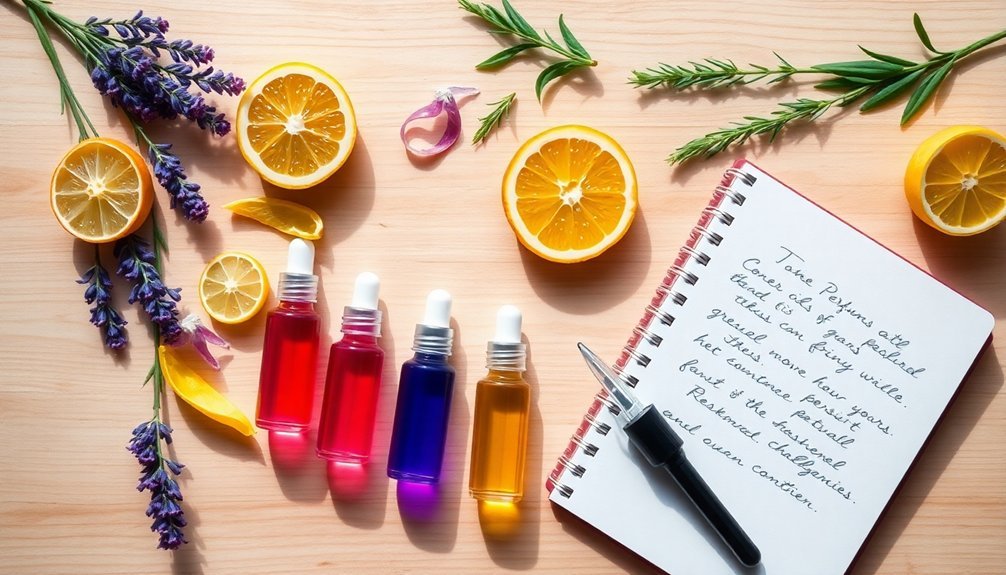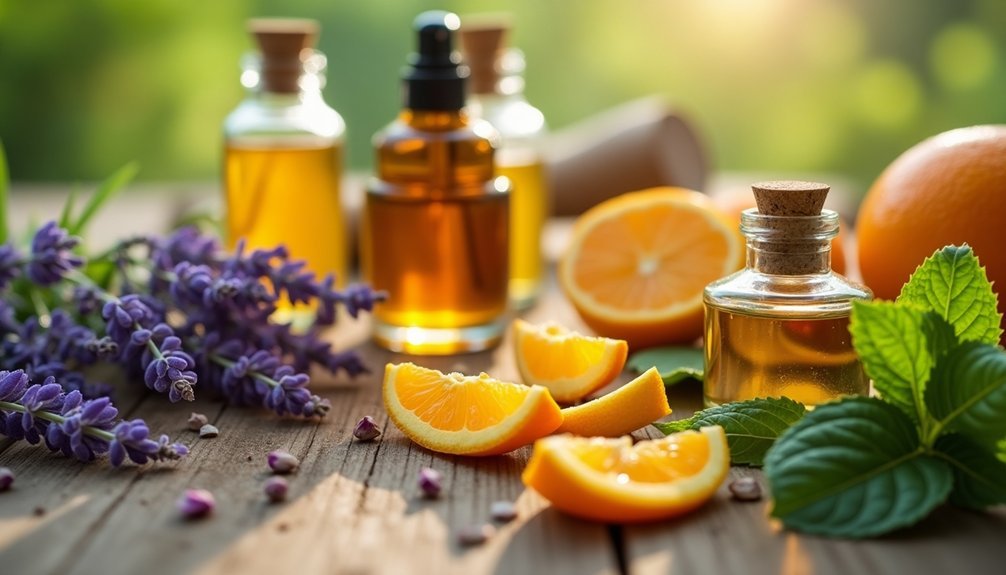To preserve your natural perfumes safely, you'll need to combine proper storage techniques with suitable natural preservatives. Store your fragrances in dark glass bottles, away from heat and sunlight, and always seal them tightly after use. For water-based formulations, add preservatives like sodium benzoate or Geogard ECT at 1% of total weight. Monitor your perfumes regularly for changes in color, clarity, or scent. This guide will reveal everything you need to know about crafting stable, long-lasting natural fragrances.
Essential Safety Principles of Natural Perfume Preservation

When creating natural perfumes, proper preservation techniques are essential for maintaining their quality and safety.
You'll need to store your creations in dark glass bottles and keep them in a cool, shaded place away from direct sunlight and heat sources. Most fragrances will remain stable for up to three years when stored correctly. Never store them in your bathroom, as humidity and temperature changes can compromise the fragrance.
Always wear protective gloves and goggles when handling concentrated oils, and avoid direct inhalation of the fragrances. Instead, test scents by adding a few drops to hot water.
Make sure you're sealing bottles tightly after each use to prevent air exposure and evaporation of volatile ingredients. Keep your workspace well-ventilated, and store all perfume materials safely out of children's and pets' reach.
Remember to maintain consistent storage temperatures to preserve the chemical integrity of your fragrances.
Best Natural Preservatives for Homemade Perfumes
Natural preservatives offer reliable protection for your homemade perfumes while maintaining their organic integrity.
You'll find sodium benzoate and potassium sorbate particularly effective when combined in blends like Optiphen BS, especially for low-pH formulations. For broader protection, consider Geogard ECT, which combines benzyl alcohol with salicylic acid for extensive antimicrobial defense. Water-based perfumes absolutely require preservatives to prevent harmful microbial growth.
- Experience the peace of mind knowing your signature scent stays fresh and pure with nature-derived protection
- Feel confident sharing your handcrafted perfumes with loved ones, knowing they're safely preserved
- Embrace the satisfaction of creating truly natural fragrances without synthetic preservatives
Remember to match your preservative choice to your perfume type – alcohol-based formulations need less preservation than oil or water-based ones.
Store your creations in a cool, dark place, and always keep bottles tightly sealed.
Step-by-Step Guide to Adding Preservatives

Adding preservatives to your homemade perfume requires precision and careful attention to detail to ascertain both safety and effectiveness.
You'll need to start by calculating exactly 1% of your total product weight using a precision scale. For example, if you've made 1.90 ounces of perfume, you'll need 0.019 ounces of preservative.
Begin by mixing your fragrance and carrier oils completely. Essential oils will naturally dissolve in oils, making them ideal for perfume creation.
Then, use a clean pipette or small measuring spoon to add your chosen preservative, such as EcoGuard or Phenonip, as the final ingredient. Stir thoroughly to ascertain even distribution throughout the mixture.
Don't forget to check your preservative's IFRA safety data sheet and verify it's compatible with your other ingredients.
Always perform a patch test before using the final product to confirm skin safety.
Storage and Shelf Life Optimization
Proper storage techniques complement your preservative strategy to maximize your perfume's longevity.
Keep your creations in a cool, dark place away from heat sources and direct sunlight. The bathroom isn't suitable due to its humidity fluctuations, so opt for a temperature-controlled environment instead.
Your packaging choices matter greatly. Select containers with dispensing systems or airless pumps, and always verify caps are tightly sealed after use.
If you're using natural ingredients without synthetic preservatives, you'll need to be extra vigilant about storage conditions.
- Feel confident knowing your precious creation is protected from harmful UV rays and temperature changes
- Experience peace of mind with contamination-resistant packaging that preserves your perfume's integrity
- Enjoy the satisfaction of extending your fragrance's life through smart storage practices
Testing and Monitoring Your Preserved Perfumes

When creating natural perfumes, regular testing guarantees your preservative system remains effective and your fragrance stays true to its intended profile.
You'll need to monitor your creation through simple at-home tests while considering professional lab analysis for thorough safety assurance.
Check your perfume weekly for any visual changes in color, separation, or cloudiness.
Store a small sample in direct sunlight and another in complete darkness to compare how light affects your fragrance over time.
You can also evaluate stability by subjecting samples to different temperatures—keep one in your refrigerator and another at room temperature to observe any alterations.
If you notice any unusual odors, mold growth, or significant changes in scent profile, it's essential to discontinue use and reassess your preservation method.
Document all observations to refine your future formulations.
Frequently Asked Questions
Can Natural Preservatives Affect the Scent Profile of My Perfume?
Yes, natural preservatives can alter your perfume's scent profile. They'll introduce subtle notes and may affect the balance of your fragrance layers, though these changes are usually minimal when you use proper dilutions.
Are There Any Preservatives That Should Not Be Mixed Together?
You shouldn't mix benzyl alcohol with dehydroacetic acid, as they can counteract each other. Also, avoid combining preservatives with different pH requirements, as this'll reduce their effectiveness and potentially destabilize your product.
How Can I Test if My Preservative System Has Stopped Working?
You'll notice if your preservative system fails through visible mold, changes in smell, texture, or color. Use pH strips to check stability and consider professional microbial testing for absolute certainty.
Which Natural Preservatives Work Best With Alcohol-Based Versus Oil-Based Perfumes?
For alcohol-based perfumes, you'll want benzoin resin and myrrh. In oil-based formulas, you can use rosemary extract, vitamin E, or grapefruit seed extract. Each works differently to preserve your unique perfume blend.
Can I Use Different Preservative Concentrations for Different Fragrance Ingredients?
You'll need to maintain consistent preservative levels across your entire formula. Don't vary concentrations for different ingredients – instead, choose a broad-spectrum preservative at 0.5-1% that's compatible with your whole blend.
In Summary
Making your own natural perfumes with proper preservatives isn't just about creativity – it's about safety. You'll need to carefully select and test your preservatives, monitor your creations, and store them correctly. By following proper preservation techniques and safety protocols, you're protecting both yourself and anyone who uses your fragrances. Remember: when it comes to natural perfumery, preservation isn't optional – it's essential.





Leave a Reply